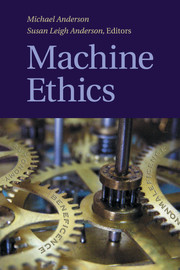Book contents
- Frontmatter
- Contents
- General Introduction
- PART I THE NATURE OF MACHINE ETHICS
- PART II THE IMPORTANCE OF MACHINE ETHICS
- PART III ISSUES CONCERNING MACHINE ETHICS
- PART IV APPROACHES TO MACHINE ETHICS
- Introduction
- 14 Towards the Ethical Robot
- 15 Asimov's Laws of Robotics
- 16 The Unacceptability of Asimov's Three Laws of Robotics as a Basis for Machine Ethics
- 17 Computational Models of Ethical Reasoning
- 18 Computational Neural Modeling and the Philosophy of Ethics
- 19 Architectures and Ethics for Robots
- 20 Piagetian Roboethics via Category Theory
- 21 Ethical Protocols Design
- 22 Modeling Morality with Prospective Logic
- 23 An Integrated Reasoning Approach to Moral Decision Making
- 24 Prototyping N-Reasons
- 25 There Is No “I” in “Robot”
- 26 Prospects for a Kantian Machine
- 27 A Prima Facie Duty Approach to Machine Ethics
- PART V VISIONS FOR MACHINE ETHICS
- References
24 - Prototyping N-Reasons
A Computer Mediated Ethics Machine
from PART IV - APPROACHES TO MACHINE ETHICS
Published online by Cambridge University Press: 01 June 2011
- Frontmatter
- Contents
- General Introduction
- PART I THE NATURE OF MACHINE ETHICS
- PART II THE IMPORTANCE OF MACHINE ETHICS
- PART III ISSUES CONCERNING MACHINE ETHICS
- PART IV APPROACHES TO MACHINE ETHICS
- Introduction
- 14 Towards the Ethical Robot
- 15 Asimov's Laws of Robotics
- 16 The Unacceptability of Asimov's Three Laws of Robotics as a Basis for Machine Ethics
- 17 Computational Models of Ethical Reasoning
- 18 Computational Neural Modeling and the Philosophy of Ethics
- 19 Architectures and Ethics for Robots
- 20 Piagetian Roboethics via Category Theory
- 21 Ethical Protocols Design
- 22 Modeling Morality with Prospective Logic
- 23 An Integrated Reasoning Approach to Moral Decision Making
- 24 Prototyping N-Reasons
- 25 There Is No “I” in “Robot”
- 26 Prospects for a Kantian Machine
- 27 A Prima Facie Duty Approach to Machine Ethics
- PART V VISIONS FOR MACHINE ETHICS
- References
Summary
Much work in machine ethics attempts to implement ethical theory in autonomous, situated machines – robots. Our previous work in robot ethics falls at the extreme of very simple virtual agents programmed with moral strategies for simple games (Danielson 1992). Even at this extreme, ethics is surprisingly complex. Our later evolvable agents discovered some strategies unexplored by the rational choice ethics literature (Danielson 1996; Danielson 1998; Danielson 2002). Twenty years ago, Dennett was skeptical of this branch of machine ethics: “[N]o remotely compelling system of ethics has ever been made computationally tractable, even indirectly, for real-world moral problems” (Dennett 1989, p. 129). We leave this approach to other contributors in this collection.
In contrast, there is the branch of machine ethics that constructs machines to advise people making ethical decisions. Our present work falls here, or so we shall argue. We have developed an innovative survey research platform – N-Reasons – to explore robot ethics at the first level and machine ethics at the second. The question of interest for this volume is if the N-Reasons platform can be usefully seen as a machine.
This contrast is interesting in another way relevant to our project. Working on Artificial Morality, the skeptical question I most often faced was, “How could a machine be moral?” The emerging technology of robotics, however, has caught up with some of this skepticism.
- Type
- Chapter
- Information
- Machine Ethics , pp. 442 - 450Publisher: Cambridge University PressPrint publication year: 2011



